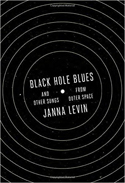
 |
Black Hole Blues and Other Songs from Outer Space
by Janna Levin
Knopf
Astronauts returning on the space shuttle once told this former satellite designer and space program physicist: "You have no idea how much gravity is pulling down on all of us." Home from the sheer joy of weightlessness in space, the dynamics of gravity were suddenly made real, pulling their shoulders and compressing their spines closer to Earth. It was a reminder of one of the universe's illusive mysteries—gravity. We can measure and explain it, but we cannot see or hear it... yet. Physicist and writer Janna Levin takes us on the journey to detect, listen for, gravitational waves as the byproduct of a gigantic collision between black holes.
In simple terms, black holes form an incredibly dense mass. For scientists, this is where the fun begins. Since mass is an essential component of gravity, the extreme density of black holes will crush atoms and even bend light under its own weight. Yes, light has weight, and therefore one cannot really see a black hole, because light becomes trapped inside of it.
Decades ago, the movie Black Hole depicted a spacecraft passing through a black hole. This is science-fantasy. Anything with mass in close proximity to a black hole will not pass through it. Instead, the atoms of the spacecraft and the crew inside will become so densely packed that the result will no longer be visible to the naked eye, not to mention eliminating the viability of the spacecraft and its occupants. A black hole generates pressure of astronomical proportions. In a world of unnecessary hyperbole, it’s literally appropriate to apply the description “astronomical proportions” to a black hole.
For the purposes of Levin's book, as two of these monster black holes draw near, anomalies in gravity will create waves that ring through space, but by the time they reach the Earth, they will be so slight that they will not be felt or heard by even the knowing. So what device will be needed to detect this phenomenon? By the mid-twentieth century, planning for and construction of full scale gravitational wave listening devices began on several international fronts. The devices needed to be big. The largest, called the Laser Interferometer Gravitational-Wave Observatory (LIGO), is run by Caltech and spans four square kilometers at two separate locations. Within its vacuum environment, LIGO waits for disturbances in a reflected laser beam as a means of sensing and measuring the dragon itself—gravity in the form of waves. It’s an enormous undertaking of scope, time, and funding.
With crisp storytelling, Levin tracks the creators of LIGO as it moves from thought to reality. The success of this device remained unseen for decades, and, as some might say, this was hardly the point. It was another step in unlocking the mysteries of the universe. The geniuses of science continue to tweak their experiments, conjure new frontiers to explore, and draw us closer to understanding. The field of scientists pursuing gravitational wave detection come from all corners of the world, and they are uplifted and hindered by their personalities. Humanity is the factor in the equation that's impossible to measure. Beyond anticipated brilliance, they reveal professional paranoia, backbiting, and of course politics. However, the work proceeds with the relentless dedication of a monk, the ambition of a CEO, and at times the ruthlessness of a pirate. Eventually, LIGO detected its first gravitational wave, which was produced by colliding neutron stars.
Levin sketches the story with impressive color, while providing Polaroid-like narratives of the people and places along this scientific frontier. She is the type of science writer who can explain complex topics in understandable terms. In relating the beloved wizards and weirdos of the laboratories, she has brought the high-minded down to earth. That feat is as rare as hearing gravity, and it reveals the genuine process of discovery. History often documents invention as brilliant strokes of insight wrought to fruition, but Levin shows its plodding pace that spans decades, as well as its inevitable wrong turns into blind alleys and heartbreaking miscues that destroy careers. No doubt, her students at Barnard love to sit in on each lecture—scientists and laymen alike. If we had a device that measured passion, Levin would ring the meters and sound the alarms.
RECOMMENDED by the US Review
Next Focus Review
Previous Focus Review